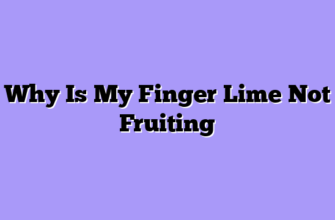When I first laid eyes on a Black Finger Lime, I thought someone was playing a trick on me. This peculiar, elongated citrus fruit looked more like something from an alien planet than a relative of the common lemon or orange. But that first taste? Pure magic. Those tiny, pearl-like vesicles bursting on my tongue with their intense citrusy flavor changed everything for me as a grower. Today, I want to share my experiences with this remarkable fruit that’s captured the hearts of chefs and food enthusiasts worldwide.
The Black Finger Lime, scientifically known as Citrus australasica, goes by several fascinating names depending on where you find yourself. Australians affectionately call it “citrus caviar” – and trust me, once you see those glistening pearls inside, you’ll understand why.
Some folks refer to it simply as the Australian finger lime, though technically that’s the broader species name covering multiple color varieties. In its native habitat along the rainforests of eastern Australia, Indigenous communities have known this fruit for thousands of years, though specific Aboriginal language names vary by region. The black variety specifically refers to the dark purple to black skin color, distinguishing it from its green, red, and pink cousins.
Understanding This Extraordinary Citrus
What makes the Black Finger Lime so special isn’t just its appearance – though that certainly turns heads at farmers’ markets. These fruits typically grow to about 2-3 inches long, resembling gnarled fingers more than conventional citrus. The tree itself, Citrus australasica var. sanguinea (the pigmented variety), remains relatively compact, usually reaching heights of 6-10 feet in cultivation, though wild specimens can stretch taller.

Growing these beauties has taught me patience and attention to detail. The trees are thornier than a defensive linebacker – seriously, I’ve got the scars to prove it. Those thorns aren’t just decorative; they’re sharp, numerous, and strategically placed to remind you to wear thick gloves during harvest. But here’s the thing: that difficulty is partly why these fruits command premium prices. At my local specialty markets, Black Finger Limes sell for anywhere from $15 to $30 per pound, sometimes even more in urban areas or high-end restaurants.
My Growing Experience and Hard-Learned Lessons
Let me tell you, my first attempt at cultivating Citrus australasica was humbling. I planted three saplings in what I thought was the perfect spot – full sun, decent drainage, regular watering schedule. Two of them struggled immediately. The third? It sulked for an entire year before finally deciding to cooperate. See, finger limes are fussy about their conditions. They want warmth but not scorching heat. They need moisture but hate wet feet. They’re basically the Goldilocks of the citrus world – everything has to be just right.
After consulting with other growers and doing extensive research, I learned that these plants evolved in the understory of Australian rainforests. That means they actually appreciate some afternoon shade in hotter climates, unlike their sun-worshipping citrus relatives. Once I moved two of my struggling trees to locations with dappled shade during the hottest part of the day, they transformed. Within six months, I saw vigorous new growth and the first flower buds that would eventually become fruit.
Here’s what I’ve learned works best for Black Finger Limes in my operation:
Optimal Growing Conditions Table
| Factor | Requirement | My Practical Notes |
|---|---|---|
| Temperature Range | 50-95°F (10-35°C) | Protect from frost; they’ll die below 28°F |
| Soil pH | 5.5-6.5 (slightly acidic) | I amend with sulfur if needed; test annually |
| Watering | Consistent moisture, well-draining | Mulch heavily; drip irrigation works best |
| Sunlight | Partial shade to full sun | 4-6 hours direct sun ideal in hot climates |
| Fertilization | Light, frequent feeding | Citrus-specific fertilizer monthly during growing season |
The fruiting timeline requires serious patience. From flower to harvest-ready fruit takes roughly 5-6 months. My trees typically bloom in late spring, meaning I’m harvesting in fall through early winter. The flowers themselves are delicate, small white blooms that appear inconspicuous compared to other citrus. But don’t let their modesty fool you – each successful pollination could become a $3-5 fruit at maturity.
Market Potential and Culinary Applications
Why would someone pay such premium prices for what amounts to a few tablespoons of citrus pearls? The answer lies in their unique properties and versatility. Those little vesicles don’t just look spectacular – they provide an intense burst of flavor that’s more complex than regular limes, with subtle hints of grapefruit and herbal notes. The texture is completely unlike any other citrus; instead of juice running everywhere, you get individual flavor bombs that maintain their integrity.
Chefs have gone absolutely wild for these fruits. I supply several high-end restaurants in my region, and I’ve seen finger lime pearls garnishing everything from oysters to desserts. They add visual drama and a pop of acidity to dishes. One chef I work with regularly uses them in ceviche, where the pearls blend perfectly with raw fish. Another creates these stunning cocktails where the pearls float suspended in clear spirits, releasing their flavor gradually as you drink.
The demand has been steadily increasing. According to specialty produce market trends, finger lime sales in North America have grown approximately 200% over the past five years. That growth isn’t just from restaurants either. Home cooks are discovering them at farmers’ markets and specialty grocers. I’ve had customers return week after week, sharing stories of impressing dinner guests or elevating their home cooking.
My Top Uses for Black Finger Lime Pearls:
- Fresh seafood applications – scatter over sashimi, ceviche, or grilled fish
- Cocktail garnishes – the visual impact alone is worth it, plus they add bursts of flavor
- Dessert components – particularly with chocolate or creamy desserts where acid balances richness
- Salad dressings – muddle some pearls into vinaigrettes for texture and zing
- Cheese plates – they cut through rich, fatty cheeses beautifully
- Preserved in salt or sugar – extends shelf life and creates unique condiments
But here’s something most articles won’t tell you: not every fruit is perfect. Sometimes you’ll cut open a finger lime and find it’s mostly rind with disappointing pearl development. This happens with insufficient pollination, water stress, or harvesting too early. I’ve learned to judge ripeness by the fruit’s slight softness when gently squeezed and a subtle color change in the skin. Too many growers harvest prematurely to hit market windows, resulting in inferior product that hurts the fruit’s reputation.
Challenges and Real Talk About Production
Let’s be honest about the difficulties. Black Finger Limes aren’t a get-rich-quick crop. The trees take 3-4 years from planting to significant production. During that time, you’re investing in irrigation, fertilization, pest management, and labor without much return. The thorns make harvesting slow and painful – I can harvest oranges probably three times faster than finger limes. And the fruits are delicate; rough handling causes the skin to split, rendering them unmarketable.
Pests present another challenge. In my experience, Asian citrus psyllid – which spreads the devastating citrus greening disease – loves finger limes just as much as conventional citrus. I maintain a strict integrated pest management program, including beneficial insects, selective spraying, and constant monitoring. One infected tree could threaten my entire operation.
Then there’s the marketing challenge. While demand is growing, it’s still a niche product. You can’t just dump finger limes at a conventional wholesale market and expect fair prices. Success requires direct relationships with chefs, presence at upscale farmers’ markets, or online sales platforms. I spend almost as much time on sales and marketing as I do on actual farming.
Critical Success Factors for Commercial Production:
- Start with quality, certified disease-free nursery stock
- Plan for 3-4 year establishment period before significant income
- Develop direct-to-chef or direct-to-consumer sales channels early
- Invest in proper irrigation and frost protection infrastructure
- Accept that yields will be lower than conventional citrus
- Price appropriately for the specialty market – don’t undervalue your product
The Verdict: Worth the Effort?
After everything I’ve shared – the challenges, the patience required, the thorny harvests – would I do it again? Absolutely. There’s something deeply satisfying about growing a fruit that genuinely excites people. When a chef calls to tell me their customers are raving about a dish featuring my finger limes, or when a home cook discovers them at my market stand and their face lights up, it validates the effort.
The economic reality is solid too. While my finger lime trees produce far fewer pounds per tree than conventional citrus, the price per pound is 5-10 times higher. My mature trees yield roughly 10-20 pounds of marketable fruit annually. At an average of $20 per pound, that’s $200-400 per tree – competitive with or better than many conventional fruit crops on a per-tree basis.
Yield and Income Comparison
| Crop Type | Average Yield/Tree | Price/Pound | Revenue/Tree |
|---|---|---|---|
| Black Finger Lime | 10-20 lbs | $20-30 | $200-600 |
| Standard Orange | 150-300 lbs | $0.50-1.50 | $75-450 |
| Standard Lime | 50-100 lbs | $1-2 | $50-200 |
Note: These are general estimates; actual results vary significantly by region, variety, and market
The Black Finger Lime represents something important in modern agriculture: the value of specialty, high-quality products in an increasingly commoditized food system. Sure, you could grow generic citrus that competes on volume and price. Or you could grow something unique that commands premium prices because it offers an experience people can’t get anywhere else.
Is it for every farmer? Definitely not. You need patience, attention to detail, marketing savvy, and a willingness to work with a crop that doesn’t follow the conventional playbook. But if you’re looking for a specialty crop that’s genuinely exciting, that chefs and food enthusiasts actively seek out, and that can generate solid returns on a small footprint, Citrus australasica deserves serious consideration.
These peculiar, finger-shaped fruits have taught me that sometimes the best opportunities in farming come from looking beyond the ordinary. The Black Finger Lime isn’t just a fruit – it’s a conversation starter, a culinary tool, and a reminder that innovation in agriculture doesn’t always mean new technology. Sometimes it means rediscovering and cultivating the unusual gifts that nature has been perfecting for millennia.








